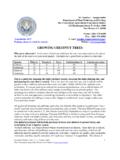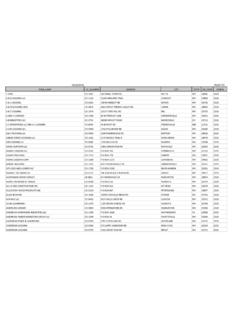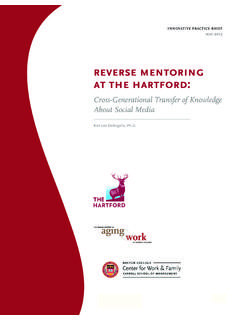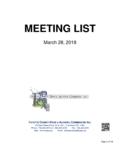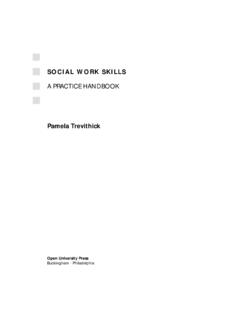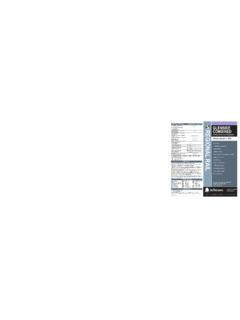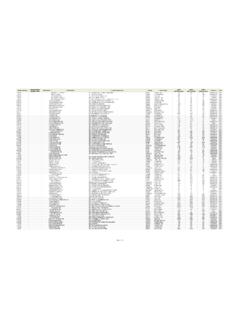Transcription of Pruning Chestnut Trees - CHESTNUT HILL …
1 Pruning CHESTNUT Trees There are many reasons to prune Trees . The most important reason is to keep the tree healthy. Removing broken or damaged branches, diseased sections, and keeping a balanced tree are all important reasons to prune CHESTNUT Trees . When considering when to prune an orchardist has two times in the annual growth cycle of the tree , winter and summer Pruning . Most of the Pruning occurs in the winter on dry days. It is during the winter Pruning the shape and height of the tree is addressed. During the summer Pruning only the growth that is unwanted is removed as well as any diseased portions of the tree .
2 If any branches break during the growing season these should be removed as soon as possible. Do not wait for the winter Pruning for their removal. Never remove more than 1/3 of the tree in any one year. CHESTNUT Trees do not produce nuts on shaded branches. Prune when the tree is dormant, corrective Pruning consists of removing broken, interfering, dead, or disease branches. Remove branches that are growing toward the middle of the tree . If any branches are crossing, remove one of them. Prune low limbs that may interfere with mowing or harvesting. Remove limbs and vigorous shoots growing through the center, to allow light and air to penetrate.
3 In the early years, if secondary limbs show narrow angles, you should remove them. CHESTNUT Trees naturally will grow 18 to 48 inches or more in a year as long as the growing conditions permit. The Trees will continue to grow until they reach their genetically determined height. Some types of CHESTNUT Trees can reach a height of up to 80 feet. Some types of CHESTNUT Trees reach their maximum height of 40 feet and then only grow out depending on available space. CHESTNUT Trees , like many other fruiting Trees , can be kept much lower than their natural height through annual Pruning .
4 Also, like other fruiting Trees , CHESTNUT Trees will produce more nuts per tree or per acre if the Trees are pruned in ways that maximize nut production. What and Where to Prune After you get your tree into the shape you want, all you need to do is maintain it. This can be done pretty quickly with a winter Pruning . Here is a list of things you should prune: Suckers are branches that grow off of the roots. Watersprouts are like suckers, but they grow straight up in the interior of the tree . Weak V-Crotches are places where the secondary branch is coming off of the primary branch at steep angle.
5 This creates a weak bond and has the highest chance of breaking in the future. You want the crotches to look more like a U- shape. Cross limbs or limbs that cut across the tree and run into other branches should be removed. Vertical growth either up or down should be removed to encourage outward growth for better light penetration and picking. Stubs and broken branches should be removed to prevent disease and remove pest entry points. Double leaders or competing leaders should be removed. This causes competition and dwarfed fruit. Pick the strongest leader and remove the weak one.
6 Whorls are competing branches at the same level of the primary leader. Similar to double leaders, this will cause competition. To achieve both shape and good production, think of the root system of the new tree as a water pump. Any stems greater than the size of the main stem should be considered leaks in the main water pipe. Any stem over the size of the main stem is stealing water from the main stem you are trying to push. The shoot, which you are pushing, will become an extension of the main stem. Pruning during or shortly before rain (2-3 days) can provide a path for disease to enter the tree .
7 Water dripping into the open new cuts is the most common path of infection. CHESTNUT Trees for the most part do not bleed. Without the bleeding, new cuts are left vulnerable until the exposed area is healed. Photo 1. A two-year-old CHESTNUT tree , planted without any Pruning . Secondary branches are taking over the central leader, as the tree was never trained. In its second year, a severe crotch has developed, making it difficult to tell which stem is the leader. Branches smaller than the size of the main stem can stay, as they do not significantly reduce the amount of water to the top of the tree (Photo 2).
8 Pruning and training of a young tree should begin the first year after transplanting. Training should take place gradually over several years and no more Pruning should be done than is necessary to enhance the natural shape or structural strength of the tree (Photo 2). The objective in the first few years is to identify and correct problems with the main framework of the tree . Most Trees are grown with one central leader (the top most vertical branch). When a young tree has competing leaders, the weaker ones should be removed. If they are essentially equal, either can be removed.
9 Photo 2. A tree similar to that in Photo 1 but in this case, the two-year-old tree received early Pruning . The following year the lateral branches under the main leader stem will be removed even though they have burs. These branches are too low to maintain a good shape to the tree , which needs to be trained upward.. Photo 3. The Photo shows the before and after Pruning process. Notice the small growth tube which is acting as a tree (mouse) guard, not a growth tube. As mentioned above, Pruning and training should start when Trees are young. This will prevent many serious problems before they develop.
10 Older, neglected Trees are more difficult, dangerous, and expensive to prune Older Trees should be done when they are dormant; there is less weight on the limbs. At this time, it is easier to see the framework of the branches. Pruning of young Trees should be done when problems can be observed. Also, it is important to mention that properly trained and pruned Trees will yield high quality nuts much earlier and overall the health of the tree will be very significant and last longer. Always remember that the primary objective of training and Pruning is to develop a strong tree framework that will support nut production.

